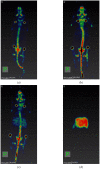Preparation of Zirconium-89 Solutions for Radiopharmaceutical Purposes: Interrelation Between Formulation, Radiochemical Purity, Stability and Biodistribution
- PMID: 31003494
- PMCID: PMC6514948
- DOI: 10.3390/molecules24081534
Preparation of Zirconium-89 Solutions for Radiopharmaceutical Purposes: Interrelation Between Formulation, Radiochemical Purity, Stability and Biodistribution
Abstract
Zirconium-89 is a promising radionuclide for nuclear medicine. The aim of the present work was to find a suitable method for obtaining zirconium-89 solutions for radiopharmaceutical purposes. For this purpose, the ion exchange behavior of zirconium-89 solutions was studied. Radio-TLC (thin layer chromatography) and biodistribution studies were carried out to understand speciation of zirconium-89 complexes and their role in the development of new radiopharmaceuticals. Three methods of zirconium-89 isolation were studied using ZR (hydroxamate) and Chelex-100 resins. It was found that ZR-resin alone is not enough to obtain stable zirconium-89 formulations. An easy and effective method of reconstitution of [89Zr]Zr-oxalate to [89Zr]Zr-citrate using Chelex-100 resin was developed. Developed procedures allow obtaining [89Zr]Zr-oxalate (in 0.1 M sodium oxalate solution) and [89Zr]Zr-citrate (in 0.1-1.0 M sodium citrate solution). These solutions are perfectly suitable and convenient for radiopharmaceutical purposes. Our results prove [89Zr]Zr-citrate to be advantageous over [89Zr]Zr-oxalate. During evaluation of speciation of zirconium-89 complexes, a new TLC method was developed, since it was proved that there is no comprehensive method for analysis or zirconium-89 preparations. The new method provides valuable insights about the content of "active" ionic form of zirconium-89. The interrelation of the chromatographic behavior of zirconium-89 preparations and their biodistribution was studied.
Keywords: Chelex-100; DFO; ZR hydroxamate resin; citrate; oxalate; purification; radiochemical purity; stability; transchelation; zirconium-89.
Conflict of interest statement
The authors declare no conflict of interest. The founding sponsors had no role in the design of the study; in the collection, analyses, or interpretation of data; in the writing of the manuscript, and in the decision to publish the results.
Figures





Similar articles
-
[89Zr]ZrCl4 for direct radiolabeling of DOTA-based precursors.Nucl Med Biol. 2024 Sep-Oct;136-137:108943. doi: 10.1016/j.nucmedbio.2024.108943. Epub 2024 Jul 26. Nucl Med Biol. 2024. PMID: 39094425
-
The impact of zirconium-89 solution formulation on the efficiency of [89 Zr]Zr-deferoxamine synthesis.J Labelled Comp Radiopharm. 2022 Nov;65(13):326-337. doi: 10.1002/jlcr.4003. Epub 2022 Oct 8. J Labelled Comp Radiopharm. 2022. PMID: 36138551
-
Evaluation of a chloride-based 89Zr isolation strategy using a tributyl phosphate (TBP)-functionalized extraction resin.Nucl Med Biol. 2018 Sep-Oct;64-65:1-7. doi: 10.1016/j.nucmedbio.2018.06.003. Epub 2018 Jun 18. Nucl Med Biol. 2018. PMID: 30015090 Free PMC article.
-
From Bench to Bedside: Patient-Oriented Radiopharmaceutical Development in Nuclear Medicine Based on the Example of [89Zr]Zr-PSMA-DFO.Molecules. 2023 Dec 28;29(1):185. doi: 10.3390/molecules29010185. Molecules. 2023. PMID: 38202768 Free PMC article. Review.
-
PET imaging with ⁸⁹Zr: from radiochemistry to the clinic.Nucl Med Biol. 2013 Jan;40(1):3-14. doi: 10.1016/j.nucmedbio.2012.08.004. Epub 2012 Sep 19. Nucl Med Biol. 2013. PMID: 22998840 Free PMC article. Review.
Cited by
-
89Zr-Radiolabelling of p-NCS-Bz-DFO-Anti-HER2 Affibody Immunoconjugate: Characterization and Assessment of In Vitro Potential in HER2-Positive Breast Cancer Imaging.Pharmaceutics. 2025 Jun 4;17(6):739. doi: 10.3390/pharmaceutics17060739. Pharmaceutics. 2025. PMID: 40574051 Free PMC article.
-
A new solid target design for the production of 89Zr and radiosynthesis of high molar activity [89Zr]Zr-DBN.Am J Nucl Med Mol Imaging. 2022 Feb 15;12(1):15-24. eCollection 2022. Am J Nucl Med Mol Imaging. 2022. PMID: 35295887 Free PMC article.
-
On the Versatility of Nanozeolite Linde Type L for Biomedical Applications: Zirconium-89 Radiolabeling and In Vivo Positron Emission Tomography Study.ACS Appl Mater Interfaces. 2022 Jul 27;14(29):32788-32798. doi: 10.1021/acsami.2c03841. Epub 2022 Jul 13. ACS Appl Mater Interfaces. 2022. PMID: 35830285 Free PMC article.
-
Biodistribution of Mesenchymal Stromal Cells Labeled with [89Zr]Zr-Oxine in Local Radiation Injuries in Laboratory Animals.Molecules. 2023 Oct 19;28(20):7169. doi: 10.3390/molecules28207169. Molecules. 2023. PMID: 37894647 Free PMC article.
-
Separation of 44Sc from 44Ti in the Context of A Generator System for Radiopharmaceutical Purposes with the Example of [44Sc]Sc-PSMA-617 and [44Sc]Sc-PSMA-I&T Synthesis.Molecules. 2021 Oct 21;26(21):6371. doi: 10.3390/molecules26216371. Molecules. 2021. PMID: 34770780 Free PMC article.
References
-
- Knapp F.F., Dash A. Radiopharmaceuticals for Therapy. Springer; New Delhi, India: 2016. Introduction: Radiopharmaceuticals Play an Important Role in Both Diagnostic and Therapeutic Nuclear Medicine; pp. 3–23.
-
- Qin Z. Recent advances of injectable radiopharmaceuticals for nuclear imaging and therapy: A new era in nuclear medicine. Mater. Technol. 2015;30:B250–B255. doi: 10.1080/10667857.2015.1104829. - DOI
MeSH terms
Substances
Grants and funding
LinkOut - more resources
Full Text Sources
Other Literature Sources

